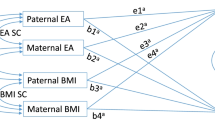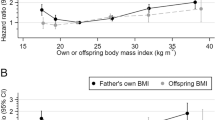Abstract
Previous studies have documented spousal and intergenerational correlations in body mass index (BMI) but few have considered familial weight data augmented with socioeconomic and behavioral control variables. This article considers a U.S. dataset that contains such information on husbands, wives, and grown children. Although certain variables (like education, race, and smoking status) are helpful in explaining an individual’s BMI, the BMI of one’s spouse (or parents) remains the most significant predictor of BMI. To help distinguish between correlation and causality in the married-adult BMI regressions, we consider two alternative approaches for dealing with possible endogeneity (due to omitted variables): (1) including spousal variables to proxy for omitted variables and (2) modeling spousal BMI in a hierarchical framework to explicitly allow for a “couple” effect. The results suggest endogeneity of educational attainment, but not smoking status, and support prior research that finds different associations of BMI with income for husbands and wives. For grown children, parental BMI and smoking status are identified as significant predictors.
Similar content being viewed by others
References
Anderson PM, Butcher KF, Levine PB (2003) Maternal employment and overweight children. J Health Econ 22: 477–504
Cawley J (2004) The impact of obesity on wages. J Hum Resour 39: 452–474
Cawley J, Markowitz S, Tauras J (2004) Lighting up and slimming down: the effects of body weight and cigarette prices on adolescent smoking initiation. J Health Econ 23: 293–311
Center for Studying Health System Change (2005) Community Tracking Study 2003 Household Survey Public Use File: user’s guide. Technical Publication No. 58. Washington, DC
Chamberlain G (1982) Multivariate regression models for panel data. J Econ 18: 5–46
Chou S-Y, Grossman M, Saffer H (2004) An economic analysis of adult obesity: results from the Behavioral Risk Factor Surveillance System. J Health Econ 23: 565–587
Classen T, Hokayem C (2005) Childhood influences on youth obesity. Econ Hum Biol 3: 165–187
Conley D, Glauber R (2006) Gender, body mass and socioeconomic status: new evidence from the PSID. Adv Health Econ Health Serv Res 17: 255–280
Cutler DM, Glaeser EL, Shapiro JM (2003) Why have Americans become more obese?. J Econ Perspect 17: 93–118
Finkelstein EA, Fiebelkorn IC, Wang G (2004) State-level estimates of annual medical expenditures attributable to obesity. Obes Res 12: 18–24
Flegal KM, Carroll MD, Ogden CL, Johnson CL (2002) Prevalence and trends in obesity among US adults, 1999–2000. J Am Med Assoc 288: 1723–1727
Gruber J, Frakes M (2006) Does falling smoking lead to rising obesity?. J Health Econ 25: 183–197
Jeffery RW, Rick AM (2002) Cross-sectional and longitudinal associations between body mass index and marriage-related factors. Obes Res 10: 809–815
Lakdawalla D, Philipson T (2009) The growth of obesity and technological change. Econ Hum Biol 7: 283–293
Maes HHM, Neale MC, Eaves LJ (1997) Genetic and environmental factors in relative body weight and human adiposity. Behav Genet 27: 325–351
Manson JE, Skerrett PJ, Willett WC (2004) Obesity as a risk factor for major health outcomes. In: Bray GA, Bouchard C (eds) Handbook of obesity: etiology and pathophysiology, 2nd edn. pp 813–824. Available at http://books.google.com/books?id=t-Ccv0QGmeAC
Metcalf CE, Kemper P, Kohn LT, Pickreign JD (1996) Site definition and sample design for the Community Tracking Study. Center for Studying Health System Change, Technical Publication No. 1. Washington, DC. Available at http://www.hschange.com/CONTENT/157/157.pdf
Philipson TJ, Posner RA (2003) The long-run growth in obesity as a function of technological change. Perspect Biol Med 46: S87–S107
Price RA, Reed DR, Guido NJ (2000) Resemblance for body mass index in families of obese African American and European American women. Obes Res 8: 360–366
Rice T, Despres JP, Daw EW, Gagnon J, Borecki IB, Perusse L, Leon AS, Skinner JS, Wilmore JH, Rao DC, Bouchard C (1997) Familial resemblance for abdominal visceral fat: the HERITAGE family study. Int J Obes 21: 1024–1031
Sacerdote B (2004) What happens when we randomly assign children to families? NBER working paper 10894
Stunkard AJ, Sorensen TI, Hanis C, Teasdale TW, Chakraborty R, Schull WJ, Schulsinger F (1986) An adoption study of human obesity. N Engl J Med 314: 193–198
Taveras EM, Rifas-Shiman SL, Berkey CS, Rockett HRH, Field AE, Lindsay Frazier A, Colditz GA, Gillman MW (2005) Family dinner and adolescent overweight. Obes Res 13: 900–906
Vogler GP, Sorensen TI, Stunkard AJ, Srinivasan MR, Rao DC (1995) Influences of genes and shared family environment on adult body mass index assessed in an adoption study by a comprehensive path model. Int J Obes 19: 40–45
Wilson SE (2002) The health capital of families: an investigation of the inter-spousal correlation in health status. Soc Sci Med 55: 1157–1172
Wilson FA (2006) Explaining the growth of child obesity in the U. S. University of Chicago Department of Economics, mimeo. Available at http://chess.uchicago.edu/ccehpe/hew_papers/winter_2006/Wilson%202006.pdf
Wolf AM, Colditz GA (1998) Current estimates of the economic cost of obesity in the United States. Obes Res 6: 97–106
Wooldridge JM (2002) Econometric analysis of cross section and panel data. MIT Press, Cambridge, MA
World Health Organization (2003) Obesity and overweight: fact sheet. http://www.who.int/dietphysicalactivity/media/en/gsfs_obesity.pdf. Accessed 9 Jan 2005
Author information
Authors and Affiliations
Corresponding author
Rights and permissions
About this article
Cite this article
Abrevaya, J., Tang, H. Body mass index in families: spousal correlation, endogeneity, and intergenerational transmission. Empir Econ 41, 841–864 (2011). https://doi.org/10.1007/s00181-010-0403-6
Received:
Accepted:
Published:
Issue Date:
DOI: https://doi.org/10.1007/s00181-010-0403-6




